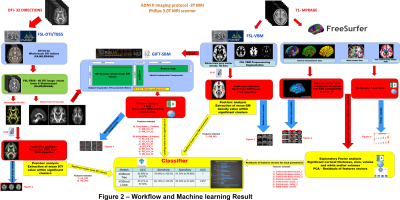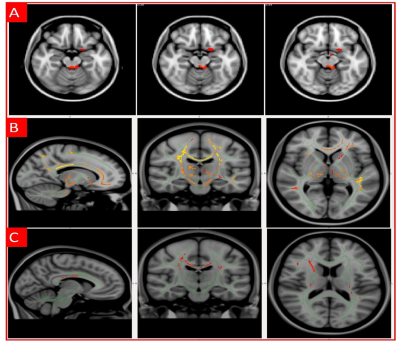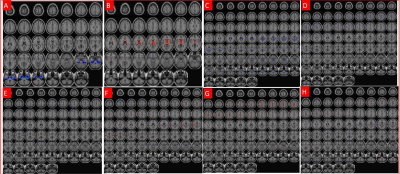3251
Multiparametric MRI characterization of microstructural substrate of literacy: Observations from a community cohort of literate and illiterate elderly in India1Neurology, National Institute of Mental Health and Neurosciences, Bangalore, BANGALORE, India, 2Nizam's Institute of Medical Sciences Hyderabad, Hyderabad, India, 3Nizam's Institute of Medical Sciences, Hyderabad, Hyderabad, India, 4University of Hyderabad, Hyderabad, India
Synopsis
Few studies have evaluated neuroanatomical differences between illiterates and literates and majority have been unimodal investigations. We explore multiparametric, neuroanatomical substrates of literacy by studying grey and white matter microstructural neuroimaging biomarker differences between 61 literate and 15 illiterate elderly subjects with normal cognition. Univariate and multivariate methods for grey matter density, diffusion tensor parameters and cortical/subcortical morphometric measures were employed. Literacy provided an advantage through increase in grey matter density, white matter integrity, cortical thickness, area and volumes in brain areas related to reading, writing, language, Visuospatial and sensorimotor processes. Enhanced white matter integrity was the most discriminating factor on the machine learning.
Introduction
One fifth of the world’s population are illiterate, but the neuroanatomical substrate of literacy is less well established1. With increasing evidence that literacy and education reduce risk of dementia, there is a compelling need to study the neural basis of this protective effect2. With recent growth in neuro-computational methodology, development of multimodal MRI methods, there is a unique opportunity to study effects of literacy on brain grey and white matter structures and their connectivity, thereby providing insights into neural mechanisms that underlie the role of literacy and education on enhancing cognitive reserve3.Methodology
All 76 subjects were participants of the Tata longitudinal study of cognitive ageing, a community based study of elderly that aims to determine risk and protective factors for dementia in India. All subjects had normal cognition, based on a detailed cognitive examination. (Figure 1) MRI imaging was done according to ADNI II protocol. The voxel wise comparison of DTI parameters and grey matter density was evaluated with FSL software. Free surfer’s automated vertex wise cortical morphometric data (cortical thickness, area and volume) and subcortical segment structures data were used for evaluation of group-wise difference and from significant regions, feature reduction done with PCA and feature vectors residuals used as features.(figure 2) From the FSL outputs, multivariate pattern analysis using GIFT- SBM tool box was to obtain ICA based structural components and the SBM loadings of the components which had group difference were retained as features. The features thus derived were used for binary classification and feature prediction importance using two ensemble machine learning technique XGBoost Tree and XGBoost Linear on SPSS modular software4-10.Results
Literates performed better than illiterates on all neuropsychological tests (Table 2). Voxel wise comparison of DTI parameters of literates demonstrated increased FA in bilateral white matter tracts including superior longitudinal fasciculus, cingulum, corticospinal tract, posterior thalamic and optic radiations, corsona radiata, superior and inferior cerebellar peduncle. Further, FA was increased on the left side in the left inferior longitudinal fasciculus and inferior fronto-occipital fasciculus. In parallel, RD was reduced in widespread white matter tracts. Grey matter density based univariate voxel-wise analysis demonstrated increased grey matter density in literates in left hippocampus, parahippocampus and lingual gyrus, and bilateral thalami.(Figure 3) Cortical morphometric analysis showed increased cortical thickness involving bilateral parietal, temporal and occipital regions. Common areas that showed increase in cortical thickness, area and volumes were bilateral inferior parietal regions (left more than right), supramarginal and post central gyri. Additionally, increased cortical volumes were noted in left insula and entorhinal areas among literates. White matter volume was higher in bilateral lingual, cingulate regions, left superior parietal as well as right fusiform, parahippocampal and pericalcarine regions.(Figure 4) Multivariate voxel-wise analysis for structural networks demonstrated two grey matter components, one consisting of bilateral medial and lateral temporal structures and the other component consisted of subcortical deep thalamo-striatal regions. The FA_ICA_02 component included wider network of white matter including the corpus callosum, bilateral internal capsule as well as brain stem white matter tracts while the component FA_ICA_29, consisted predominantly of subcortical white matter involving the fronto-temporo-parietal regions.(Figure 5) Nineteen extracted features used for discriminant analysis of literate and illiterate using supervised machine learning showed a high accuracy in differentiating these conditions with mean FA values extracted from significant clusters and grey matter ICA component consisting of thalamo-striatal regions demonstrating highest predictor importance.
Discussion
In comparison to illiterates, literates not only performed better in a range of cognitive tasks but also maintained better white matter integrity in diffuse white matter tracts, connecting cortical as well as subcortical areas. More specifically, increased connectivity was observed in left inferior fronto-occipital fasciculus, and increased cortical thickness in inferior parietal region, both structures associated typically with function of reading. Literacy was also associated with increased grey matter density in dominant cerebral hemisphere involving language regions. Multiple grey and white matter structural networks that support functions of Visuospatial and sensorimotor functions were also demonstrated, that may have added advantage to literacy11. Supervised ensemble machine learning was able to discriminate between these conditions and the enhanced white matter integrity was the most important predicting factor contributing for this distinction leading to enhanced connectivity among literates.Conclusion
Literacy provides an additional neuroanatomical advantage over illiteracy, through enhanced white matter integrity, increased grey matter density in specific cortical and subcortical structures. Multiparametric MRI indices indicate that networks related not just to reading and writing, but also visuospatial cognition, inter and intra-hemispheric transfer of information and sensorimotor processes may play a role in enhancing cognition and potentially providing cognitive resilience in literates.Acknowledgements
No acknowledgement found.References
1) Alfredo Ardila, Paulo H. Bertolucci, Lucia W, et al. Illiteracy: The Neuropsychology of Cognition Without Reading, Archives of Clinical Neuropsychology.2010; 25(8):689–712.
2) Dekhtyar S, Wang HX, Scott K, et al. A Life-Course Study of Cognitive Reserve in Dementia--From Childhood to Old Age. Am J Geriatr Psychiatry. 2015; 23(9):885-96.
3) Veronese E, Castellani U, Peruzzo D, et al. Machine learning approaches: from theory to application in schizophrenia. Computational and Mathematical Methods in Medicine.2013: 2013; 1-12.
4) Smith SM, Jenkinson M, Johansen-Berg H, et al. Tract-based spatial statistics: voxelwise analysis of multi-subject diffusion data. Neuroimage. 2006; 31(4):1487-505.
5) Douaud G, Smith S, Jenkinson M, et al. Anatomically related grey and white matter abnormalities in adolescent-onset schizophrenia. Brain: 2007; 130:2375-2386.
6) Good CD, Johnsrude IS, Ashburner J, et al. A voxel-based morphometric study of ageing in 465 normal adult human brains. NeuroImage.2007; 14:21-36.
7) Smith SM, Jenkinson M, Woolrich MW,et al . Advances in functional and structural MR image analysis and implementation as FSL. NeuroImage 2004; 23 Suppl 1:S208-219.
8) Fischl B, Salat DH, Busa E, et al. Whole brain segmentation: automated labeling of neuroanatomical structures in the human brain. Neuron. 2002; 33: 341-355.21.
9) Caprihan A, Abbott C, Yamamoto J, et al. Source-based morphometry analysis of group differences in fractional anisotropy in schizophrenia. Brain Connectivity.2011; 1(2):133-145
10) Jerome H. Friedman. Greedy Function Approximation:A Gradient Boosting Machine. Annals of Statistics 2001; 29(5) 1189-1232 11) Petersson KM, Silva C, Castro-Caldas A, et al. Literacy: a cultural influence on functional left-right differences in the inferior parietal cortex. Eur J Neurosci. 2007; 6(3):791-9.
Figures




